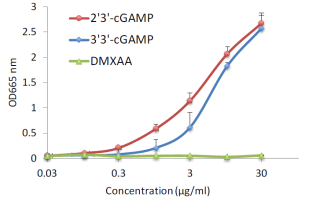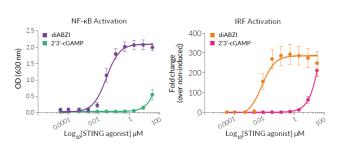STING (stimulator of interferon genes) is essential for the interferon (IFN) response to cytoplasmic foreign or self-DNA and directly senses cyclic dinucleotides (CDNs), such as 2’3’-cGAMP. Activation of STING leads to IFN regulatory factor (IRF3)-dependent type I IFN production and NF-κB-dependent inflammatory cytokine production. Additionally, signal transducer and activator of transcription 6 (STAT6) has been reported to be recruited to STING for TBK1-mediated phosphorylation during viral infection. Interestingly, a variety of natural non-synonymous variants of human STING that affect CDN recognition and signal transduction have been identified.
InvivoGen has developed a collection of HEK293-derived reporter cells to facilitate the monitoring of STING-mediated responses.
HEK293 STING Reporter cells express the most relevant variants of STING as well as the secreted embryonic alkaline phosphatase (SEAP) reporter gene under the control of an IRF or STAT6 promoter. Some of them additionally express Lucia, a secreted luciferase, placed under the control of the endogenous IFN-β promoter. The two reporter proteins, SEAP and Lucia Luciferase, can be readily measured in the supernatant by using QUANTI-Blue™ and QUANTI-Luc™, respectively.



